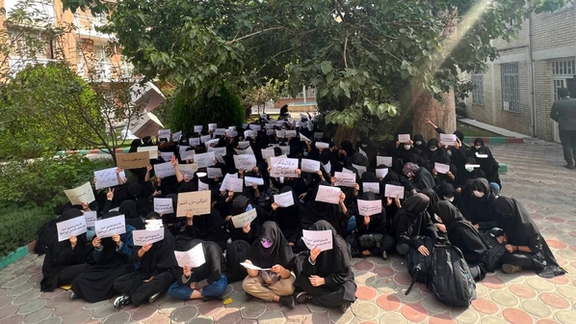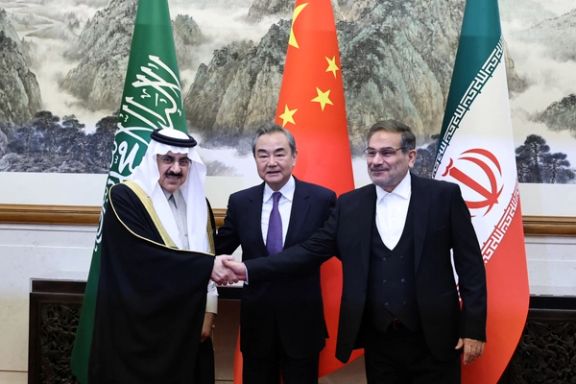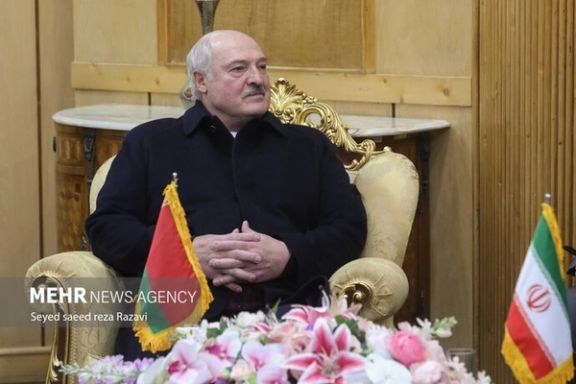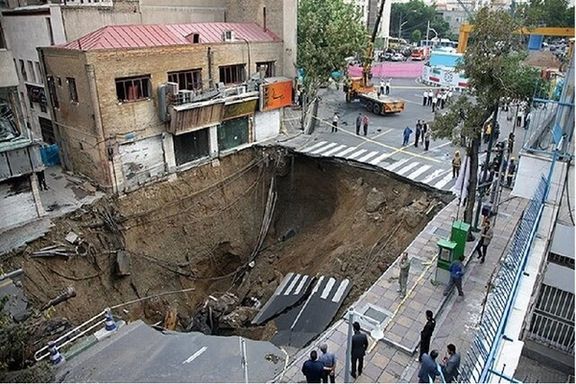Iran Regime Mounts Pressure On Students After Protests Against Poisonings

Iran’s security forces have summoned dozens of students to punish them for staging protests against the poisoning of schoolgirls across the country.

Iran’s security forces have summoned dozens of students to punish them for staging protests against the poisoning of schoolgirls across the country.
Reports from Iran say dozens more students have been banned from entering the universities of Tehran and Tabriz, a tactic which has been used throughout the Woman, Life, Freedom protests which began in September.
Having been one of the main centers of popular protests, the regime has increased the number of security agents at campuses and beefed up inspection of the students’ belongings.
According to the country's Student Union Council, 40 students of Tabriz University of Medical Sciences were summoned to the disciplinary committee after they held protests against the mysterious chemical attacks which have taken place in scores of schools and dormitories since November.
Activist Zia Nabavi claimed that last week, he and a number of other students of Allameh University in Tehran were banned from entering the campus after they staged a protest against the serial poisonings which have affected hundreds of girls across the country.
Last week, over 300 university professors condemned the organized chemical attacks in a statement, declaring that the perpetrators of the "horrible crime" are among the "cruelest, most dangerous and most hated" enemies of children and teenagers.
"This is a shame that despite claims to protect domestic and cross-border security, the government has not taken preventive measures in the face of this obvious threat to national security," read the statement.

After the recent announcement of the détente with Saudi Arabia, the Islamic Republic hopes this will expedite rapprochement with other regional nations.
Speaking at his last press conference in the current Iranian year -- which ends on March 20 – the country’s Foreign Ministry Spokesman Nasser Kanaani said not only will the detente benefit the two nations, but expand diplomatic horizons and regional peace, especially in the Persian Gulf.
“Fortunately, with the positive atmosphere that we are witnessing in the region, this positive development [the deal with Saudi Arabia] can happen in connection with other regional countries as well, including Bahrain.
“We should further trust the path of diplomacy and take steps in this direction,” he explained, adding that the region would also benefit from a similar détente in relations between Iran and Egypt.
“Egypt is an important country and the two countries value each other in the region. The region needs the synergy of Tehran and Cairo,” he added. “The Islamic Republic’s principled policy is strengthening relations with its neighbors. We are [also] definitely ready to develop ties with Jordan.”
After five long rounds of talks spanning Baghdad, Muscat and Beijing, the agreement would see the two archenemies restore diplomatic ties and reopen embassies seven years after their relations were severed.
Saudi Arabia cut ties with Iran in 2016 after its embassy in Tehran was stormed during a dispute between the two countries over Riyadh's execution of a Shi'ite Muslim cleric.
The kingdom also has blamed Iran for missile and drone attacks on its oil facilities in 2019 as well as attacks on tankers in Persian Gulf waters. Iran denied the charges.
Yemen’s Iran-aligned Houthi movement has also carried out cross-border missile and drone attacks into Saudi Arabia, which leads a coalition fighting the Houthis, and in 2022 extended the strikes to the United Arab Emirates.
Kanaani said that embassies in Tehran and Riyadh and consulates in Mashhad and Jeddah will reopen within two months, though this two month period is time for Saudi to assess the behavior and commitment of the regime as it lays out conditions for the relationship. Among the most contentious issues, is Iran’s refusal to agree to controls over its regional proxies or the activities of the IRGC.
Saudi Foreign Minister Prince Faisal bin Farhan bin Abdullah openly stated that the agreement to restore relations with Iran does not mean disputes have been resolved. In an interview with London-based Asharq Al-Awsat, he said the agreement announced March 10 in Beijing with Chinese mediation and apparent guarantees, shows a joint desire by Iran and Saudi Arabia to “resolve disputes through communication and dialogue,” but “this does not mean that an agreement has been reached to resolve all pending disputes between them.”
Touching on the issue of the war in Yemen, Kanaani said the end of the war on the impoverished country has always been one of the top priorities of the Islamic Republic. “It is expected that the new positive atmosphere, which has been formed in the Iran-Saudi relations, will have positive and good results in the issue of Yemen.”

Iran insists it is doing a prisoner swap with the US in spite of the Biden administration’s categoric denials of the Iranian claims.
The Iranian foreign ministry says the "written agreement has been signed by the official representative of the United States” though has failed to specify who.
Iran’s Foreign Ministry Spokesman Nasser Kanaani told a weekly press conference on Monday that “a written agreement regarding the exchange of prisoners was signed through an intermediary” in March 2022.
However, in what can be seen as a back peddling, he claimed that the deal "has not been implemented by the US government so far for various reasons”, suggesting the announcement was perhaps premature.
"In recent weeks, there has been an exchange of indirect messages to update the deal," he added.
Iran’s foreign minister Hossein Amir-Abdollahian told state TV Sunday: “Regarding the exchange of current prisoners between Iran and the US, we have reached an agreement within the past few days. If everything goes well on the American side, I think we will witness a prisoner exchange in the near future. We see this as an entirely humanitarian case.”
A White House official immediately denied Amir-Abdollahian's statement calling it “a cruel lie”, but reiterated that the United States is committed to securing the release of Americans held in Iran.
Several Iranian-American citizens, including Siamak Namazi, Emad Sharqi, and Murad Tahbaz, are still imprisoned in Iran. In exchange for the release of the hostages, in addition to demanding money, the Islamic Republic plans to urge Washington to release the Iranians imprisoned in the US for circumventing sanctions or their involvement in terror activities.

Agreement to restore relations with Iran does not mean disputes have been resolved, Saudi Foreign Minister Prince Faisal bin Farhan bin Abdullah has said.
In an interview with London-based Asharq Al-Awsat, bin Farhan emphasized that the agreement announced March 10 in Beijing with Chinese mediation and apparent guarantees, shows a joint desire by Iran and Saudi Arabia to “resolve disputes through communication and dialogue.”
He underscored, however, “This does not mean that an agreement has been reached to resolve all pending disputes between them.”
The biggest dispute is the conflict in Yemen where the two countries have fought each other indirectly for 8 years. Iran has backed Houthi rebels who pushed the internationally recognized government out of the capital and proceeded to conquer territories beyond their ethnic-religious traditional domain.
As Saudi Arabia backed the anti-Houthi forces with direct military involvement, Houthis used Iranian missiles and drones to launch hundreds of attacks against targets inside Saudi territory.
Most analysts believe that Riyadh wants to end the Yemen conflict as it embarks on an ever-ambitious plan of economic development, which needs security.

Executive Director of The Washington Institute Robert Sadloff in a long series of tweets Sunday referred to the Saudi quest for fast economic growth, quoting a senior Saudi official who said growth “can be sidetracked through insecurity, whether from Houthi missiles or the threat of [Iranian] nuclear blackmail.”
The Saudi foreign minister in his interview emphasized the economic factor. “We, in the Kingdom, hope to open a new chapter with Iran and bolster cooperation that would consolidate security and stability and push forward development and prosperity, not just in both our countries, but the entire region.”
Former Iranian diplomat Javid Qorban-Ogli told Didban website in Tehran Monday that ending the Yemen conflict is the top Saudi objective. “Saudi Arabia is a conservative regime which tries to avoid headaches. It pursues an ambitious development plan, which needs security and stability in the region.”
He also listed Tehran’s reasons for resuming relations with Riyadh. “Iran, the other side in this agreement, is facing a serious economic crisis, social and political chaos and multiple other crises because of its wrong foreign policy.” The third actor in this deal is China, he said, adding that Beijing seeks “energy security.”
Iran’s foreign ministry spokesman Naser Kanaani Monday reiterated that the agreement with the Saudis is the result of nearly two years of talks in Baghdad and Oman, taken to a higher level in recent months by Chinese mediation. His remark shows that although the two sides could have reached an agreement without Beijing, one or both countries at some point decided to have China some sort of guarantor.
Sadloff also argued in his tweets that Riyadh to an extent lost confidence in the Biden administration for securing Iran’s containment. As Tehran expands it nuclear program getting closer to a nuclear threshold state and Washington maintains restrictions on arms sales to Riyadh, Saudi Arabia’s confidence in receiving American protection decreased.
“Resuming ties with Iran is a dramatic expression of this lack of confidence in US,” Sadloff said.

The President of Belarus is on a visit to Tehran to discuss bilateral ties between the two economically challenged nations and close Russia allies.
Alexander Lukashenko, dubbed "the last dictator of Europe", will meet with Iran’s First Vice-President Mohammad Mokhber, parliament speaker Mohammad-Baqer Qalibaf, and Iran’s ruler Ali Khamenei, Iran’s supreme leader.
The visit will focus on“emphasis on trade and economic cooperation,” including industry, agriculture, transport, and logistics, according to Lukashenko’s press agency.
“Special attention will be paid to the situation in the region and the world in general,” the press release stated, adding that several agreements on “areas of mutual interest” will be signed.
Alexander Lukashenko, Putin’s ally in the war against Ukraine, said last month that the global situation of Iran and Belarus has forced the two countries to have closer links.
Belarus mainly exports potassium fertilizer, wood and fibers to Iran and imports food products from the Islamic Republic. Annual trade between the two dictatorships reached a peak of just $100 million in 2022, the trip aiming to increase that significantly.
The presidents of Iran and Belarus made the pledge for greater cooperation on the sidelines of the 16th Shanghai Cooperation Organization summit in Samarkand in September, to be led by the two countries’ foreign ministers.

Experts in Iran warn the current land subsidence situation in Iran is “critical", claiming it puts the lives of more than 39 million people at risk.
Several factors have caused the situation to reach breaking point, including dam construction, climate change, inefficient water consumption by agriculture and industries, and the use of underground aquifers as sources for illegal agricultural water extraction wells.
Ali Beitollahi, heading the disaster task force on the issue at the Road, Housing and Urban Development Research Center of Iran, said the approximate area of subsidence zones in the country is now 18.5 million hectares, almost 11% of Iran's total area.
Beitollahi has been warning of the danger for several years, and says if action is not taken, it endangers the lives of nearly 49% of Iran’s population.
He said, ”Three hundred and eighty cities and 9,200 villages are at risk of land subsidence, and in some cases the entire area of the cities are located in the subsidence zones.”
Tehran, Razavi Khorasan in the east and Esfahan in central Iran are the provinces most at risk, Razavi Khorasan in the most imminent danger.
However, international reports claim the danger is even worse, nearing a humanitarian crisis. Science journal claims that more than 98% of Iran's 1.648 million km of land faces land subsidence.

Internationally, a rate of subsidence greater than 4mm per year is considered a crisis and yet Iran's land is sinking at an astonishing rate of 6cm per year as a result of 25 years of water level decline in the plains.
Ground subsidence in urban areas have resulted in power outages, bursting of gas pipes, deformation of rails, emergence of sinkholes, tilting of buildings, the appearance of cracks and ditches in roads and even loss of human life.
Continued water level declines will reduce the ground's water permeability and turn fertile plains into barren deserts.
Kamran Davari from Ferdowsi University of Mashhad, told ISNA state news agency that many cases of subsidence have been reported from some areas in the Mashhad plain in the northeast where subsidence is between at least 3cms and a staggering 15-17.5cms in the northwest of Mashhad city. Davari said the situation had reached “hyper critical”.
Based on the underground water quality zoning map, the areas with good water quality have decreased drastically in Mashhad over the past decade.
"If the electrical conductivity of water exceeds 1,500, it indicates that the water is no longer suitable for drinking,” explained Davari. “Unfortunately, in the eastern areas of Mashhad, the electrical conductivity is currently between 3,000 to 5,000.”
The journal Taylor & Francis Online confirms the fears. In research last year, it claimed: “The province of Razavi Khorasan in the northeast of Iran had the largest area (about 3500 km2) vulnerable to land subsidence occurrence”.
It warned of other risk-prone areas in the future. “Based on the land subsidence susceptibility map, the provinces of Ardabil, Kurdistan, West and East Azerbaijan, Sistan and Baluchistan and Kermanshah, although not currently undergoing a high rate of land subsidence, will be at high risk of severe land subsidence in the future.”